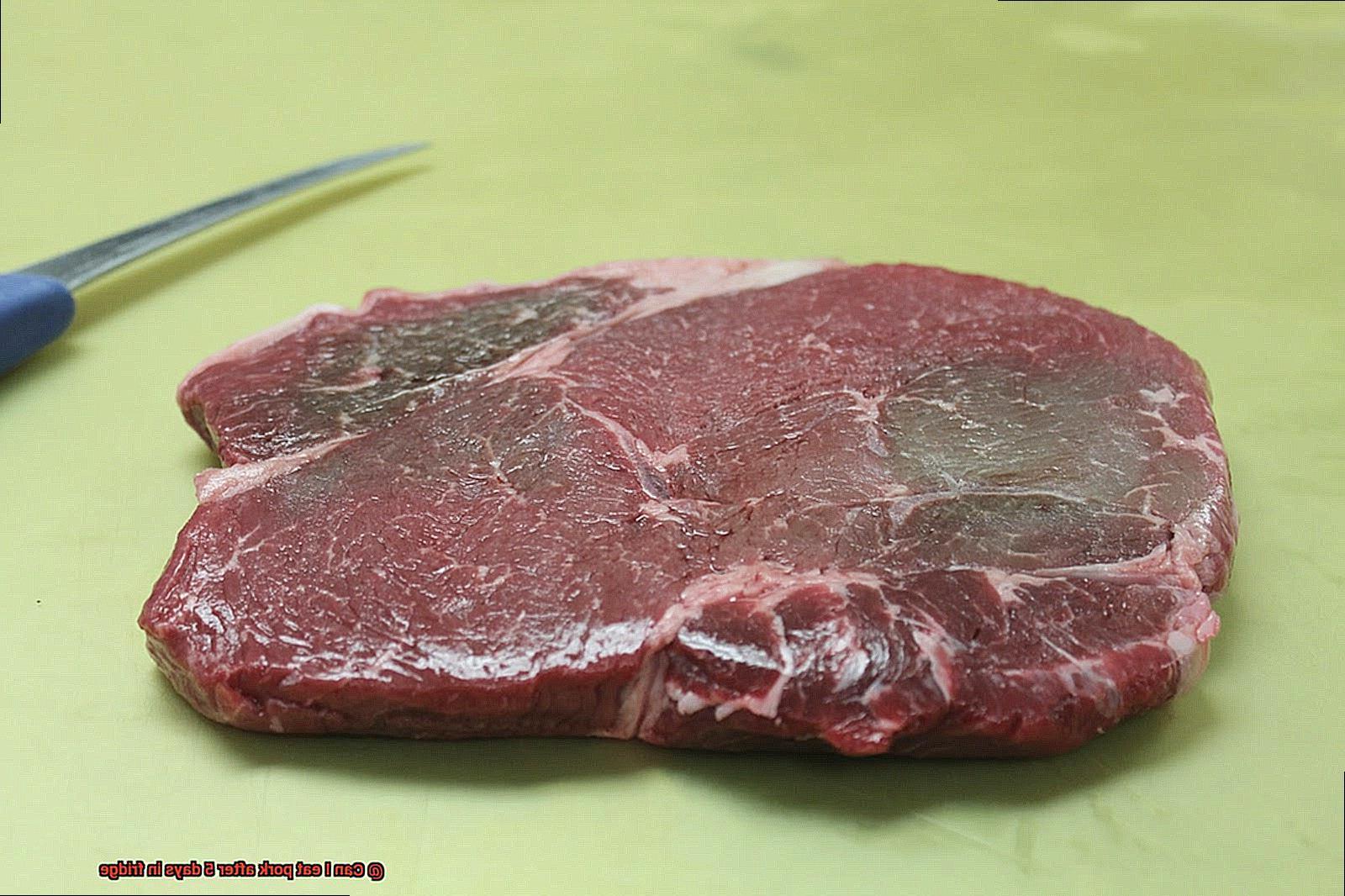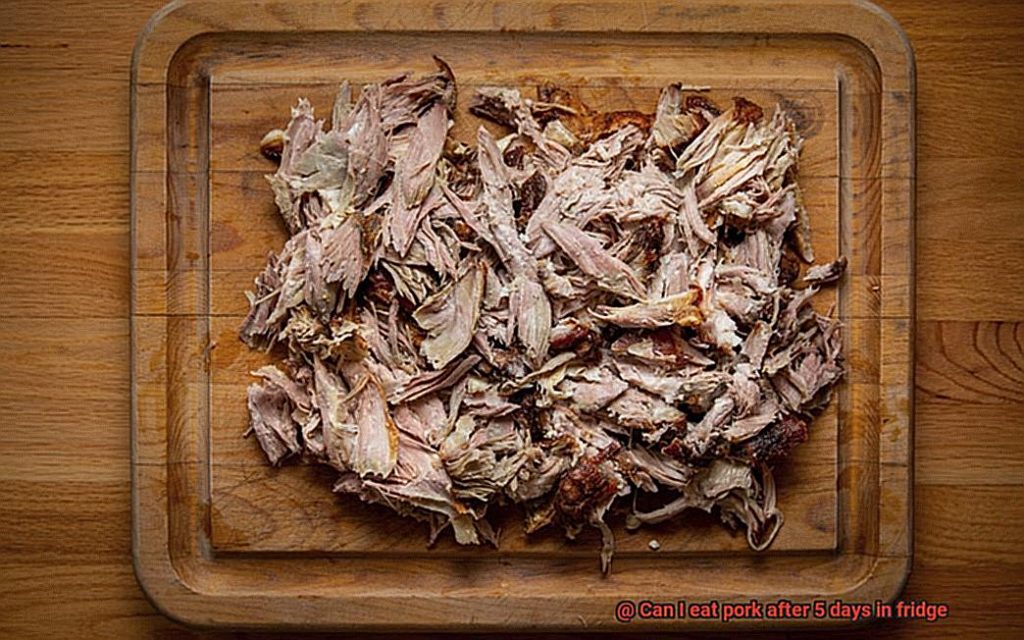Food safety is no joke, and we all want to chow down on meals that won’t make us sick. Pork is a popular protein source, but can you still eat it after it’s been chilling in the fridge for five days? That’s the million-dollar question.
Pork can be a scrumptious addition to your diet, but improper handling can turn it into a breeding ground for bacteria. In this blog post, we’re diving deep into whether or not it’s safe to consume pork after five days in the fridge.

We’ll dish out the science behind food spoilage and what happens when meat goes bad. Spoiled pork isn’t something you want to mess with, as it can lead to some nasty food-borne illnesses. But don’t worry; we’ll also share tips on how to store pork safely so that it stays fresh for as long as possible.
If you’re a fan of pork dishes and want to ensure that your meals are healthy and risk-free, read on. We’ve got everything you need to know about eating pork after 5 days in the fridge.
Contents
What is the Ideal Temperature for Storing Raw Pork?
To keep your pork safe for consumption, it is essential to store it at the right temperature.
According to the USDA, raw pork should be stored at a temperature below 40°F (4°C) in the refrigerator. This is because temperatures between 40°F (4°C) and 140°F (60°C) are considered the “danger zone,” where bacteria can grow rapidly. By keeping your pork below 40°F, you can prevent any potential bacterial growth and maintain its freshness.
It’s important to note that the ideal temperature for storing raw pork may vary depending on the type of pork product and how it’s packaged. For instance, ground pork should be stored at a maximum of two days at 40°F, while larger cuts of pork can be stored up to five days at the same temperature.
Proper storage techniques play a vital role in ensuring that raw pork stays fresh and safe to eat. To keep your pork fresh, wrap it tightly in plastic wrap or aluminum foil to prevent air from getting in and causing freezer burn. It’s also essential to store it on the bottom shelf of your fridge, away from any ready-to-eat foods that may come into contact with it.
If you’re unsure whether or not your pork is safe to eat after five days in the fridge, it’s better to be safe than sorry. Consuming spoiled meat can lead to foodborne illness, which can cause symptoms such as diarrhea, vomiting, and fever. It’s simply not worth risking your health.
Does the Type of Pork Affect How Long it Can Be Stored?
The amount of fat content in different pork types can impact how quickly bacteria grows on the meat, and ultimately affect its storage life.
Leaner cuts of pork, such as tenderloin or pork loin, can last up to five days in the fridge before needing to be cooked or frozen. But if you’ve got a fatty cut of pork like shoulder or bacon, make sure to consume it within three days of being stored in the fridge. This is because bacteria tend to grow at a faster rate on fattier cuts of meat.
What about processed pork products like sausage or ham? Some of these items have preservatives added to them that can extend their shelf life. Still, it’s crucial to follow the recommended storage guidelines on the packaging and consume these products within a reasonable amount of time.
Don’t forget that the temperature of your fridge plays a vital role in determining how long pork can be stored. The FDA recommends keeping your fridge at 40°F or below to slow down bacterial growth on food. Maintaining the right temperature is key to extending the shelf life of your pork.
Overall, proper storage guidelines and cooking methods are essential for ensuring that your pork remains safe and fresh for consumption. To help ensure you don’t risk getting sick from spoiled meat, keep these points in mind:
- Leaner cuts last longer than fatty cuts
- Processed pork products may last longer due to preservatives, but still follow packaging guidelines
- Refrigerate at 40°F or below
- Consume within recommended timeframes
How to Check if Pork is Spoiled?
Pork is a versatile meat that is used in a variety of dishes. However, consuming spoiled pork can lead to severe food poisoning symptoms such as nausea, vomiting, diarrhea, and fever. Therefore, it is crucial to know how to check if pork is spoiled before consuming it. Here are five ways to determine if pork is safe to eat:
Sight
The color of the pork can indicate spoilage. Fresh pork should appear pinkish-red with white fat. If the meat appears gray or brownish in color or has yellowish fat, it may be spoiled. Additionally, green or blue spots on the pork could indicate mold and should be discarded.
Smell
The odor of the pork can also indicate spoilage. Fresh pork should have a mild odor or no odor at all. If the pork has a strong, unpleasant smell, it is likely spoiled and should not be eaten. A sour or ammonia-like smell could indicate bacterial growth.
Touch
The texture of the pork can also indicate spoilage. Fresh pork should feel firm and spring back when touched. If the meat feels slimy or sticky to the touch, this could indicate bacterial growth and the meat should not be consumed.
Expiration Date
Always check the expiration date on the packaging of the pork. If the date has passed, it is best to discard the meat even if it appears and smells fresh. The expiration date is an important indicator of how long the meat can be safely consumed.
Use a Food Thermometer
To ensure that pork is cooked thoroughly and any harmful bacteria present are destroyed, use a food thermometer to measure the internal temperature of the meat. Pork should be cooked to an internal temperature of 145°F (63°C). This step is particularly important if you are cooking ground pork.
Is It Safe To Eat Pork After 5 Days in the Fridge?
First and foremost, you need to ensure that your pork has been stored at the correct temperature of 40°F or below. This will help to prevent the growth of bacteria that can cause foodborne illnesses. Assuming that you have stored it correctly, it is generally safe to consume after five days.
However, it’s essential to note that the quality of the meat may have deteriorated over time. As meat sits in the fridge, it can develop a sour or off odor, which is a sign that it may no longer be safe to eat. Therefore, before cooking your pork, it’s essential to perform some checks.
One of the crucial checks is to give the meat a good sniff. If it smells sour or off, it should not be consumed. Next, check for any signs of discoloration or sliminess. These can be signs that bacteria have started to grow on the meat and it could be unsafe to eat.
If your pork passes these checks, then it should be safe to consume after five days in the fridge. However, if you still have doubts about its safety or unsure about its freshness, it’s always best to err on the side of caution and discard it. Remember, it’s better to waste some food than risk getting sick from consuming spoiled meat.
What Are The Risks of Eating Spoiled Pork?
While it might be tempting, it is crucial to understand the potential risks of consuming spoiled pork.
Spoiled pork can harbor dangerous bacteria, such as Salmonella, Listeria, and E. coli. These bacteria can cause food poisoning and other severe health problems, including dehydration, kidney failure, and even death. Symptoms of food poisoning from consuming spoiled pork include nausea, vomiting, diarrhea, abdominal pain, and fever.

To avoid these risks, it is essential to store pork correctly and consume it within three to four days of refrigeration. If you are unsure about the freshness of your pork, use the “sniff test” or look for any signs of discoloration or slime on the meat. If you detect any off odor or texture changes, discard the pork immediately.
Cooking pork thoroughly is also vital to reduce the risk of foodborne illness. The internal temperature of pork should reach a minimum of 145°F for at least three minutes to kill harmful bacteria.
In addition to these steps, here are some helpful tips to keep in mind:

- Always wash your hands thoroughly before and after handling raw pork.
- Store pork at a temperature below 40°F.
- Freeze pork if you do not plan on consuming it within three to four days.
- Use separate cutting boards and utensils for raw and cooked pork.
Tips To Help You Store Pork Safely
When it comes to storing pork safely, there are several important tips that you should keep in mind. Whether you’re cooking up some juicy pork chops or making a big batch of pulled pork, proper storage techniques can help prevent the growth of harmful bacteria that can cause foodborne illness. Here are five sub-sections that will help you store pork safely:
Keep it cold
Pork needs to be stored at a temperature of 40°F or below to slow down the growth of bacteria. This means storing it in the coldest part of the refrigerator, away from other foods that may contain bacteria. If your fridge isn’t cold enough, it’s best to adjust the temperature or consider purchasing a separate fridge for your meat.
Use proper packaging
Pork should be stored in airtight containers or wrapped tightly in plastic wrap or aluminum foil to prevent air and moisture from getting in. This will help keep your pork fresh and prevent spoilage. Avoid using paper-based packaging as it can absorb moisture, which can lead to bacterial growth.
Use it within the recommended time frame
The length of time that pork can be safely stored in the refrigerator depends on the cut and how it was packaged. Generally, raw pork can be stored in the refrigerator for up to five days, while cooked pork can be stored for up to four days. It’s important to use your pork within this time frame to avoid spoilage and potential illness.
Label and date your pork
It’s important to label and date your pork so that you know when it was purchased or cooked and when it needs to be used by. This can help you avoid eating pork that has been stored for too long and is potentially unsafe to consume.
Freeze if necessary
If you’re not going to use your pork within the recommended time frame, it’s best to freeze it. Pork can be frozen for up to six months, but be sure to wrap it properly and label it with the date. Freezing can help extend the shelf life of your pork and ensure that it stays safe to eat.
What to Do If You Suspect Your Pork Has Spoiled?
Pork is a popular meat worldwide, but it has the potential to spoil quickly and cause foodborne illnesses. If you suspect that your pork has spoiled, you need to take quick action to ensure your safety. Here are five sub-sections to consider:
Assess the Pork’s Appearance, Smell, and Texture
The first step in determining if your pork has spoiled is to assess its appearance, smell, and texture. Spoiled pork will have a slimy texture, a foul odor, and a grayish-brown color. If you detect any of these signs, discard the meat immediately.
When in Doubt, Discard It
Sometimes, the signs of spoilage may not be apparent, making it difficult to determine if the pork is safe to eat. If you’re not sure about the freshness of your pork, it’s always better to err on the side of caution and discard it. Eating spoiled pork can cause serious foodborne illnesses that can lead to hospitalization or even death.
Cook Thoroughly
If you’re unsure about the safety of your pork but still want to consume it, cooking it thoroughly is essential. Cooking pork at high temperatures can kill harmful bacteria that may be present in spoiled meat. Ensure that the internal temperature of the meat reaches 145°F before consuming it.
Practice Good Hygiene
It’s crucial to practice good hygiene while handling pork to prevent cross-contamination and reduce the risk of foodborne illnesses. Wash your hands thoroughly with warm soapy water before and after handling raw meat. Clean all utensils, cutting boards, and surfaces that come into contact with raw pork with hot soapy water.
Follow Proper Food Storage Guidelines
Proper food storage is essential to prevent spoilage in the first place. Store raw pork between 32°F and 40°F in the fridge to keep bacteria growth at bay. If you’re unable to consume the meat within five days, consider freezing it to extend its shelf life.
oomojTheW5Y” >
Conclusion
In summary, the safety of consuming pork after 5 days in the fridge heavily relies on proper storage techniques and recognizing spoilage signs. Maintaining a temperature below 40°F is crucial for preserving freshness, with leaner cuts lasting up to 5 days and fattier cuts up to 3 days.
To avoid potential illness, it’s essential to package, label, and date your pork correctly. If you suspect spoilage, it’s better to discard the meat than risk getting sick from consuming it. Practicing good hygiene habits like washing hands thoroughly before and after handling raw meat can reduce cross-contamination risks.
By prioritizing food safety and following these guidelines, you can savor delicious pork dishes without compromising your well-being.






